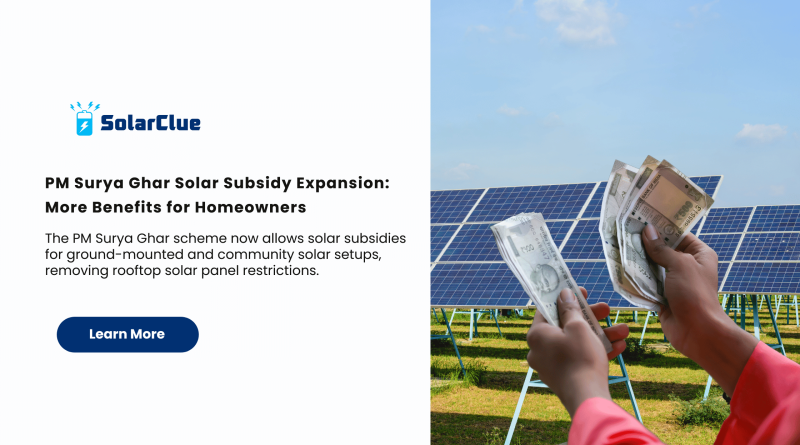PM Surya Ghar Solar Subsidy Expansion: More Benefits for Homeowners
The Indian government has taken a major step towards boosting the adoption of solar power systems with the expansion of the PM Surya Ghar scheme. Until now, homeowners had to install rooftop solar panels to avail of the subsidy. However, with the latest policy update, those with tiled roofs or living in apartment complexes can now benefit from solar panel subsidies through ground-mounted solar systems and community solar plants. This move makes solar energy more accessible and helps India progress toward a greener future while reducing dependence on fossil fuels.
Table of Contents
- 1 Key Highlights of PM Surya Ghar’s Expansion
- 2 Why This Expansion Matters
- 3 Benefits of a Solar Power System
- 4 Renewed Push for Power Distribution Privatisation
- 5 How to Apply for a Solar Panel Subsidy?
- 6 Conclusion
- 7 Frequently Asked Questions (FAQs)
- 7.1 1. What is the latest update on the PM Surya Ghar solar panel subsidy?
- 7.2 2. How much subsidy can I get for installing solar panels at home?
- 7.3 3. Can apartment residents get solar panel subsidies?
- 7.4 4. Is solar power system privatisation happening in India?
- 7.5 5. How do I apply for a solar panel subsidy?
Key Highlights of PM Surya Ghar’s Expansion
1. No More Rooftop Solar Panel Restrictions
1. Homeowners can now install solar panels for home without being limited to rooftops.
2. Residents of apartments and houses with tiled roofs can opt for ground-mounted elevated solar power systems.
3. Previously, subsidies were available only for solar panel installation on rooftops, terraces, or balconies.
2. Community Solar Panels for Apartment Residents
1. Those who cannot install rooftop solar panels can now collaborate to set up community solar plants.
2. This initiative allows apartment residents to generate and share solar energy.
3. Net metering will ensure that subsidies are distributed proportionally based on energy contribution to the power grid.
3. Attractive Solar Panel Subsidy Rates
1. 1 kW solar panel system: ₹30,000 subsidy
2. 2 kW solar panel system: ₹60,000 subsidy
3. 3 kW solar panel system: ₹78,000 subsidy
The scheme aims to install solar panels in 1 crore homes across India, significantly reducing electricity costs for households.
Why This Expansion Matters
The cost of solar panels has been a major concern for many homeowners. With the expansion of this scheme, more people can benefit from affordable solar energy. The solar panel cost can now be offset by government subsidies, making it easier for individuals to switch to renewable energy.
Benefits of a Solar Power System
1. Lower Electricity Bills: Once installed, solar panels for home significantly cut down monthly electricity expenses.
2. Eco-Friendly Energy: Solar energy is a clean and renewable source, reducing carbon emissions.
3. Energy Independence: Homeowners can produce their own power, reducing dependency on traditional electricity grids.
Renewed Push for Power Distribution Privatisation
1. Government’s Plan for Power Sector Reform
The discussion on privatising power distribution has been revived, with 10 states—including Haryana, Madhya Pradesh, and Rajasthan—seeking central support for privatisation. The goal is to improve efficiency and enhance the quality of service.
2. The Electricity Amendment Bill (2022)
1. This bill, introduced in Lok Sabha in 2022, aims to privatise power distribution similar to the telecommunications sector.
2. While some states support privatisation, others, including Kerala, have expressed concerns over potential drawbacks.
3. Opposition to Power Sector Privatisation
1. Power sector employees and state governments argue that privatisation could lead to higher tariffs and reduced public sector roles.
2. The Kerala Legislative Assembly passed a resolution opposing the bill, fearing it could favor private companies at the expense of consumers.
3. If implemented, the privatisation of power distribution could end the monopoly of state-run electricity boards, bringing significant changes to the energy sector in India.
How to Apply for a Solar Panel Subsidy?
If you are planning to install a solar power system, follow these steps to claim your solar panel subsidy:
1. Check Eligibility: Ensure your residence qualifies for the subsidy under the PM Surya Ghar scheme.
2. Choose the Right System: Decide whether you need a 1 kW, 2 kW, or 3 kW solar panel system based on your energy needs.
3. Apply Through Government Portals: Visit the official renewable energy website or contact your local electricity provider to apply.
4. Complete the Installation: Hire an authorized installer for solar panel installation.
5. Claim the Subsidy: Submit the necessary documents to get financial benefits.
Conclusion
The expansion of the PM Surya Ghar scheme is a game-changer for India’s renewable energy sector. With the removal of rooftop solar panel restrictions and the introduction of ground-mounted and community solar plants, more households can now benefit from solar panel subsidies. Additionally, the government’s push for power privatisation could lead to major changes in the energy sector, impacting both consumers and power providers. Now is the best time to switch to solar energy and take advantage of government incentives.
Looking to install a solar panel for home and cut your electricity bills? Visit our website today to learn how you can make the most of these amazing benefits!
Frequently Asked Questions (FAQs)
1. What is the latest update on the PM Surya Ghar solar panel subsidy?
The government has removed rooftop-only restrictions, allowing ground-mounted and community solar plants to be eligible for subsidies.
2. How much subsidy can I get for installing solar panels at home?
1. 1 kW solar panel – ₹30,000
2. 2 kW solar panel – ₹60,000
3. 3 kW solar panel – ₹78,000
3. Can apartment residents get solar panel subsidies?
Yes! Apartment residents can now set up community solar plants, where net metering ensures subsidies are distributed proportionally.
4. Is solar power system privatisation happening in India?
The government is discussing privatising power distribution, but it faces opposition from various states and power sector employees.
5. How do I apply for a solar panel subsidy?
You can apply through the official renewable energy portal or contact your local electricity provider for details on solar panel installation and subsidy benefits.




